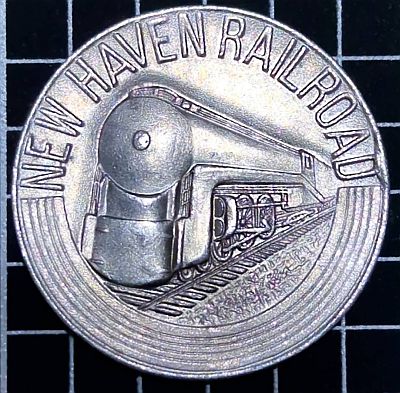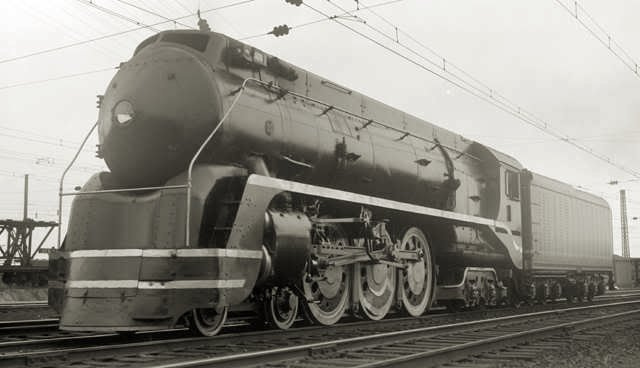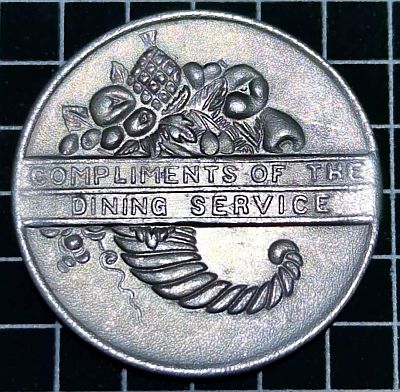A coffee token from an iconic American train
The New Haven Railroad

(1954 New Haven annual report showing the serif N over H design of the company’s logo, from Northwestern University)
The New York, New Haven and Hartford Railroad Company, commonly known as the New Haven Railroad or simply, ‘The New Haven’, operated in the states of New York, Connecticut, Rhode Island, and Massachusetts. The New Haven operated freight and passenger trains over a Boston – New York City main line and a number of branch lines.
At various points in time, the New Haven Railroad owned trolley companies, truck companies, bus companies, and steamship companies. During the early 1940s the New Haven Railroad even tried to start an airline subsidiary! The New Haven was one of the few railroads in America to operate steam, diesel, and electric locomotives at the same time.
The New Haven Railroad was formed in 1872 when the New York & New Haven and Hartford & New Haven railroads were merged together. By the turn of the century the New Haven had absorbed many smaller railroad companies, dramatically expanding from its original 450 route miles (724 km) to over 2,047 miles (3,294km) of trackage.
The New Haven Railroad was always a technologically innovative company. Early experiments in electrification were performed on several branch lines during the 1890s. These experiments resulted in the entire main line from New York City to New Haven, Connecticut being put under catenary wires by 1914.
A period of rapid expansion and questionable monopoly building efforts under the control of J. P. Morgan violated various laws. Government control during WWI saved the company from going bankrupt. Bankruptcy again threatened during the Great Depression of the 1930s, however the company remained innovative. The 1930s saw the introduction of the first streamlined passenger train, the “Comet”, and the first diesel switchers and modern, lightweight passenger cars.
Critical to the United States’ WWII war effort, by the late 1940s, the company had one of the most modern diesel passenger train fleets in the country.
By 1961, the company again went bankrupt, struggling under trustees for another eight years before being absorbed by the ill-fated Penn Central Transportation Company.
The majority of the surviving system is now owned publicly by the states of Connecticut, Rhode Island, and Massachusetts, with other surviving segments owned by freight railroads such as CSX.
Obverse

The obverse features a front-three quarter view of one of New Haven’s streamlined “I-5” class locomotives. The name of the railroad is above and five lines around the edge below the name.
“I-5” Locomotive

(Image of an “I-5” locomotive from Locomotive.Fandom.com)
The New Haven class “I-5” were 4-6-4 Hudson Locomotives, built in 1937 for the increase of passenger train traffic on the New Haven’s Shore Line requiring trains of fourteen to sixteen cars. Tests with two of these engines with a twelve-car train operating over the 156.8 miles between New Haven and Boston studied the steepest ruling grade of 0.6 to 0.7 per cent outside Boston. The locomotive needed to be able to maintain a 60-mile speed over these grades with a twelve-car 830-ton train.
Ten of these Class I-5 “4-6-4 Hudson” Tender engines were delivered in 1937, being partly streamlined but with maintenance accessibility in mind. The last ones were withdrawn and scrapped in 1951 with a life of only 14 years in service. None survive today.
Reverse

The reverse features a cornucopia or “Horn of plenty”. That is, “a curved, hollow goat’s horn or similarly shaped receptacle (such as a horn-shaped basket) that is overflowing especially with fruit and vegetables and that is used as a decorative motif emblematic of abundance”.
In front of the cornucopia is the text “Compliments of the dining service”. Numista’s entry for this piece indicates that it was a token for a cup of coffee from the dining service. The Token Catalog entry expands on this: “According to collector Marc Frattasio, author of the book “Dining on the Shore Line Route“, the aluminium tokens were distributed as a promotion when the original grill cars and rebuilt “Colonial Diners” were new. The tokens could be kept as souvenir “pocket pieces” or redeemed on the next trip for a free cup of coffee. The “Colonial Diner” cars were created from 1937-1940ish with colonial themes, such as a “Paul Revere” themed car.”
The token itself is 28mm diameter, made of aluminium (although as it is an American token, maybe we should spell it “aluminum”?). The Token Catalog entry indicates there was also a brass example, although this does not appear to be nearly as common. Numista indicates that the alignment is “Variable”. My example appears to be aligned around 90°.


Leave a Reply